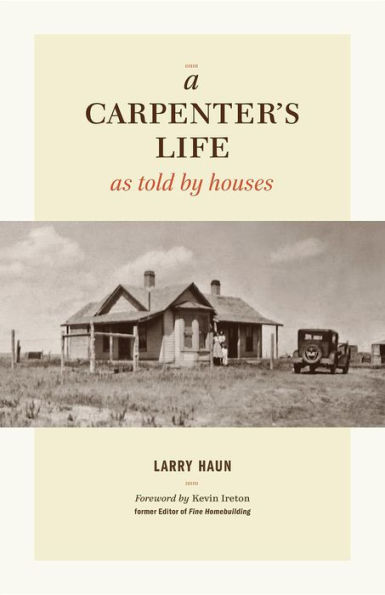Read an Excerpt
Foreword
The first time I saw Larry Haun swing a hammer, I knew that I wasn’t nearly as good a carpenter as I had thought.
It was 1987, and I had only recently walked off of a job site and into a job at Fine Homebuilding magazine. The Taunton Press was starting to make how-to videos, and one day the video producer invited me to watch an instructional tape from the United Brotherhood of Carpenters. The star was a tall, thin man in his 50’s. Over and over, he drove sixteen penny spikes with two licks—one to set and one to sink. The nails disappeared so fast I wondered if some magician’s trick were secretly pulling them into the wood ahead of the hammer blows. I never saw Joe DiMaggio play baseball, but those who did describe his movements as seamless and fluid, as having no beginning and no end. One observer quipped, “He made the rest of them look like plumbers.” That’s how I felt watching Larry Haun drive nails. Not long after I saw that video, Larry wrote his first article for Fine Homebuilding. He went on to write countless more, along with several books, mostly about the production framing techniques he helped pioneer on the frenzied tract developments of Southern California. His amazing skills were due, at least in part, to the fact that he kept at it long after most carpenters move on to jobs that are easier on their bodies. It’s telling that when Larry finally did retire and stopped building houses for a living, he joined Habitat for Humanity and started building them for free. I would like to have been there the first time Larry Haun showed up on a Habitat project. At the peak of his powers, Larry and his two brothers could frame an entire house in a day. I imagine the Habitat foreman asking Larry if he had any experience and him replying, “Some.” On the surface of it then, this book is the story of Larry’s life as seen through the houses he has known, lived in and built. This experience ranges from the sod houses of the great plains (his mother grew up in one), to the kit houses sold in the Sears catalog, to the little boxes of the post-World War II housing boom, to the McMansions of today. And given that we now take plywood, nail guns and the overflowing shelves at The Home Depot for granted, it is fascinating to read about a time when carpenters made their own framing hammers and soaked nails in paraffin so they’d be easier to drive. But it would be a mistake to think of this book simply as a carpenter’s memoir, or as a history of houses. As prodigious as Larry’s carpentry skills are, and as fascinating as the span of his career has been, neither is what makes him remarkable or this book so worthy. Larry is indeed a great carpenter, but he is hardly typical. Despite a lifetime spent on raucous job sites brimming with testosterone, Larry is a quiet, unpretentious man who has long been more interested in Buddha than Budweiser. Larry didn’t write this book to impress anybody. He’s looking for deeper truths. When he reflects on the houses in his life, it is not so much to marvel at how far we’ve come, but to see what we’ve lost, and most important, to see what we can learn. For him it is a small step from where we live to how we live. Gently and humbly, he raises questions about the decisions we’ve made as a society, about how we treat each other, and how we treat this planet that we live on. In this entire volume, otherwise filled with charming tales and timeless wisdom, only one assertion rings false. Having grown up on the high plains of western Nebraska, in an uninsulated farmhouse with no central heating, Larry says he was always cold, even in the summer. He claims that cold has dogged him to this day, which leads him to conclude “that all my efforts, all my struggles, the reason for my existence, has been to do whatever was necessary to keep myself warm.” Hardly. Anyone who has ever known Larry will attest, and readers of this book will soon discover, the reason for his existence has been to warm others with his remarkable spirit. Kevin Ireton



